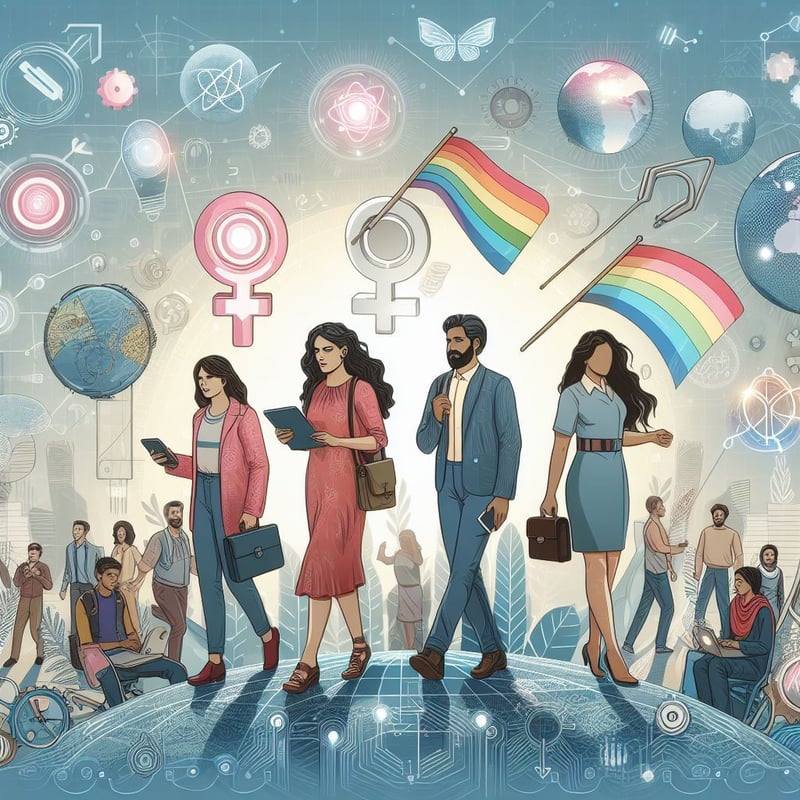dev-resources.site
for different kinds of informations.
Promoting Diversity and Looking Ahead
Welcome dear readers to the new article of the series.
This is the third post where I'll be talking why gender diversity is important in tech and why it will be beneficial for everyone in the long run. In the previous posts I've talked about why we should teach women and break the barriers so that everyone could get equal opportunities. If you haven't read that yet you could still read this but I recommend reading them as well.
Importance of Diversity
You may think that we already have a lot of skilled people working be it women or men. Why we should consider diversity at the first place? It's all about who can deliver what, isn't it? Believe me, I also had the same thought few years back but my friend this is wrong. Let me tell you why.
Diverse teams bring unique perspectives because at the end Technology is used by everyone, and having a gender-balanced team ensures that products are designed with the needs of all users in mind.
Gender diversity helps to address issues of gender discrimination and pay gaps. For instance, 57% of women working in tech have experienced gender discrimination compared to just 10% of men.
Research has shown that companies with a more gender-diverse workforce are 15% more likely to outperform their less diverse counterparts.
Transgender individuals bring valuable and often underrepresented viewpoints to the table. Their experiences can help identify potential biases in existing technologies and create solutions that are more inclusive for everyone.
Increased visibility of transgender people in tech can inspire others and create a more welcoming environment for future generations. It's important to have role models who reflect the full spectrum of gender identities.
You may think why I have made the last two points bold since all the points hold equal importance, Yes you're right but to mention still not many people are aware of the problems faced by the trans people. As someone who has the power to at least speak we should make sure that we are talking about each and everyone. Anything that ignores the rights of one third population is itself unethical.
Role of Education
Education plays a pivotal role in fostering gender diversity in tech, especially in a context like India where women and transgender people face challenges in entering the field.
Breaking Stereotypes: Education can challenge traditional gender roles that discourage women and trans individuals from pursuing STEM (Science, Technology, Engineering, and Math) fields. By exposing girls and trans students to tech subjects early on and showcasing successful women and trans professionals in tech, education can dismantle these stereotypes and spark interest.
Building Confidence and Skills: Quality STEM education equips women and trans students with the technical skills and knowledge required for tech careers. This can include coding, programming, data analysis, and problem-solving skills. With a strong foundation, they can feel confident pursuing higher education in tech fields and competing for tech jobs.
Mentorship and Role Models: Educational institutions can play a role in connecting women and trans students with mentors and role models in the tech industry. These mentors can provide invaluable guidance, support, and career advice, helping them navigate the challenges specific to their identities in the tech space.
Addressing Specific Issues: Educational policies and practices can be designed to address the specific needs of women and trans students. This might involve providing financial aid, scholarships, or support groups specifically for them. Additionally, creating a safe and inclusive learning environment where they feel respected and valued is crucial.
The Indian Scenario:
India faces a unique challenge. While the education sector is expanding, there's a gap in access and encouragement for girls and trans individuals in STEM education. Here's where education can play a vital role:
Government initiatives that focus on promoting STEM education for girls and trans students, like providing scholarships or specialized training programs.
Curriculum reforms that integrate discussions on gender diversity and inclusion in technology, showcasing the contributions of women and trans people in the field.
Collaboration between educational institutions and tech companies to create internship and career development opportunities for women and trans students.
"Diversity is the engine of innovation. When we bring together people from different backgrounds and experiences, we can unlock new ideas and solve problems in ways we never thought possible." - Marissa Mayer, former CEO of Yahoo.
Addressing Bias and Discrimination
The tech industry continues to struggle with gender bias and discrimination no matter how much we talk. Many steps have been taken globally to address it and here are some of my suggestions:
1. Diversity Training:
Unconscious Bias Awareness: Educate employees on unconscious biases, those subtle prejudices we all hold. Training should explore how these biases can manifest in hiring, promotion, project allocation, and performance reviews.
Bystander Intervention: Equip employees with tools to intervene when they witness bias against women and trans individuals. This could involve having clear reporting mechanisms and fostering a culture where speaking up is encouraged.
Inclusive Language: Promote the use of inclusive language in the workplace, avoiding gendered terms and ensuring job descriptions and communication are welcoming to all genders.
2. Inclusive Hiring Practices:
Standardized Hiring Rubrics: Develop clear and objective rubrics for evaluating candidates, focusing on skills and experience instead of subjective criteria. This helps to minimize bias based on gender presentation or communication style.
Diverse Interview Panels: Ensure interview panels are diverse in terms of gender, ethnicity, and background. This allows for a broader range of perspectives and reduces the chance of bias based on an individual's own experiences.
Blind Resume Reviews: Consider anonymizing resumes during the initial screening process to focus solely on skills and qualifications.
3. Fostering Supportive Workplace Cultures:
Mentorship Programs: Implement mentorship programs that connect women and trans individuals with experienced professionals in the tech industry. Mentors can provide guidance, support, and career advice specific to navigating challenges related to gender identity.
Employee Resource Groups (ERGs): Encourage the formation of ERGs for women and trans individuals, providing a space for networking, professional development, and peer support.
Flexible Work Arrangements: Offer flexible work arrangements like remote work or flex hours to cater to diverse needs and help create a better work-life balance, particularly beneficial for women who often shoulder a larger childcare burden.
Zero Tolerance Policy: Maintain a clear zero-tolerance policy for harassment and discrimination based on gender identity. This should be accompanied by a well-defined reporting process and clear consequences for violators.
Some Additional Considerations:
Data-Driven Approach: Track diversity metrics throughout the hiring and promotion process to identify areas for improvement and measure the effectiveness of implemented strategies.
Leadership Commitment: Strong leadership commitment is crucial for success. Leaders must actively champion diversity and inclusion initiatives and ensure accountability at all levels.
Regular Communication: Openly discuss diversity and inclusion efforts with employees. Regularly communicate goals, progress, and challenges to maintain transparency and employee engagement.
Looking into the future
The future of gender diversity in tech is a topic of ongoing discussion and research. But if anyhow we implement the above mentioned we can expect a promising future.
Here's what we can expect:
Increased Focus on Intersectionality: The conversation will move beyond just women in tech to encompass the experiences of transgender and non-binary individuals, recognizing the unique challenges they face.
Rise of Advocacy Groups: We can expect a rise in advocacy groups specifically focused on promoting the inclusion of transgender people in tech, working alongside existing organizations that support women.
Tech Designed for Everyone: As diversity in tech workforces increases, the industry will be better positioned to design technology that caters to the needs of a wider range of users, considering factors like gender identity and accessibility.
Growing Investor Interest: With research highlighting the benefits of diversity, investors may increasingly favor companies with strong diversity and inclusion (D&I) practices. This could incentivize tech companies to prioritize gender equality.
Challenges Remain: Despite the positive outlook, unconscious bias and existing gender stereotypes will persist. Additionally, ensuring equal access to STEM education for girls and trans students, particularly in developing countries, will require sustained efforts.
The Role of Technology: Ironically, technology itself can play a part in the solution. AI-powered tools can be used to identify and mitigate bias in hiring processes and performance reviews. Additionally, virtual reality (VR) has the potential to create immersive training experiences that can raise awareness of unconscious bias.
The future of gender diversity in tech is bright, but change won't happen overnight. We all have a role to play in creating a more equitable industry. Whether you're a hiring manager, an educator, or simply someone passionate about technology, there are steps you can take to break down barriers and promote inclusion. Let's work together to build a tech industry that reflects the richness and diversity of the world we live in.
This three-part blog series explored the crucial role of women in tech. We delved into the challenges they face, the triumphs they've achieved, and the strategies paving the way for a more inclusive future.
But the conversation doesn't stop here! The landscape of Women in Tech is constantly evolving.
Deepen Your Dive: Stay Informed on Women in Tech!
Sign up for our newsletter and receive exclusive updates, insightful articles, and inspiring stories delivered straight to your inbox.
This concludes our series on Women in Tech. Thank you for joining us on this journey!
Featured ones:


